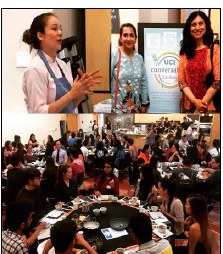India-Pakistan Diplomacy at UC Irvine
By Asma Zia
Pictures by Aisha Bajwa
Amwec

As part of American Muslim Women's Empowerment Council Interfaith group, I had the honor of attending The UCI Kitchen Event initiated by Professor Daniel Wehrenfennig.
Aisha Bajwa, also Amwec, accompanied me to this well-organized event bringing UCI's diverse student population together around food from two neighboring countries, namely, Pakistan and India.
The event commenced with the guests and facilitators being served Pakistani cuisine which included chapli kababs, raita, naan bread and mixed pickle. Guests savored the blend of spices in the kababs that were made from ground lamb meat. And raita, which is yogurt mixed with cucumbers and green coriander, was there to neutralize the stronger flavor of the kababs, if needed.
Students wanted to find out the difference between Indian and Pakistani food. "Both countries share many common spices like red chili pepper, cumin, coriander, cinnamon, and cardamom to name a few, and a major difference lies in Pakistani food revolving around meat dishes whereas Indian food mainly consists of vegetarian dishes ... but of late has started to include chicken and lamb… and that Pakistani cuisine lays a large emphasis on beef ... consumption of which is a sacrilegious in India as per their Hindu tradition, I explained.
In the second half of the event, Indian cuisine consisting of channa masala, followed by vegetable biryani, was relished by guests. Channa masala is a vegetarian dish that is actually common in both countries and consists of garbanzo beans sauteed with fried onions and many traditionally common spices from the Indian subcontinent. Also, vegetarian biryani is a rice dish that is found in both countries although the same rice dish is more often than not made with meat in Pakistan.
It is noteworthy that throughout the event we were served delicious Kasmiri chai which was a certain blend of tea slow cooked with a flavorful blend of whole spices such as green cardamon and cinnamon. This tea also aids with digestion and was a perfect end to a scrumptious meal.
Upon learning of Kashmiri tea, some students wanted to know if Kashmir was safe to visit and I honestly could not answer that question. Some wanted to know how Islam arrived in the Indian subcontinent. I answered that it was partly through invaders and partly though people that migrated from Arabia and settled in the Indian subcontinent and thus preached and spread the religion there. Also I informed the group that although Pakistan and India have traditionally been patriarchal societies...the winds of change have caught up and we are now seeing more equality in gender in both countries as women are getting more opportunities to work outside the house. Students were also surprised when they were told that there are more Muslims in India than in Pakistan. Finally, they were asked what was considered a non-consumable food in Pakistan and Asma informed them that pork was prohibited in Pakistan as the majority of the country consists of Muslims and Muslims are prohibited from consuming pork. Food brings people together and sharing our rich cultural heritage is indeed the way to dispel misconceptions.
-----------------------------------------------------------------------------

